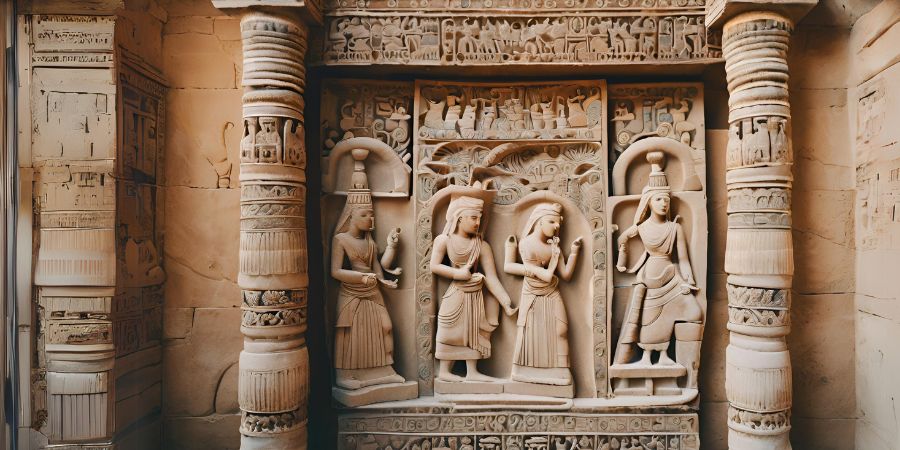The term “ancient artz” refers to the artistic expressions of early civilizations that have stood the test of time, providing valuable insights into human history and culture. From cave paintings to monumental sculptures, ancient artz offers a glimpse into the creativity, beliefs, and daily lives of people who lived thousands of years ago. In this article, we will journey through the rich history of ancient artz, examining its significance, styles, and enduring impact on modern art and culture.
The Origins of Ancient Artz
1. The Beginnings: Prehistoric Art
Prehistoric art represents the earliest form of human artistic expression, dating back to around 40,000 BCE. This era includes two primary categories:
Cave Paintings:
Cave paintings, such as those found in Lascaux, France, and Altamira, Spain, are among the most famous examples of prehistoric art. These works often depict animals like bison, deer, and horses, rendered with remarkable accuracy and detail. Scholars believe these paintings served ritualistic or symbolic purposes, reflecting early humans’ connection with nature and their surroundings.
Portable Art:
Portable art, including small figurines and carvings, was also prevalent during the prehistoric period. The Venus of Willendorf, a limestone figurine from around 28,000 BCE, exemplifies the focus on fertility and human form.
2. Ancient Civilizations and Their Art
As societies evolved, so did their art forms. The rise of ancient civilizations brought about structured artistic practices and distinct styles, many of which continue to inspire contemporary artists.
Notable Examples of Ancient Artz
1. Egyptian Art
Ancient Egyptian art, spanning over 3,000 years, is renowned for its iconic depictions of gods, pharaohs, and daily life. Key features include:
- Hieroglyphics: A combination of pictorial and symbolic writing used for religious and administrative purposes.
- Monumental Structures: The Great Pyramid of Giza and the Sphinx are testaments to the Egyptians’ architectural ingenuity and reverence for the afterlife.
- Sculptures and Paintings: Egyptian art adhered to strict conventions, with figures often portrayed in profile and with symbolic colors representing traits like divinity and fertility.
2. Mesopotamian Art
Mesopotamian art flourished in the “cradle of civilization,” encompassing cultures like the Sumerians, Akkadians, Babylonians, and Assyrians. This region produced significant contributions, such as:
- Ziggurats: Massive stepped structures serving religious purposes.
- Cylinder Seals: Intricately carved stones used to sign documents and secure goods.
- Narrative Reliefs: Depictions of battles, rituals, and hunting scenes, often found in palaces.
3. Greek Art
Ancient Greek art laid the foundation for Western artistic traditions. It evolved through three primary periods:
- Archaic Period: Known for its kouros and kore statues, characterized by rigid postures and stylized features.
- Classical Period: Marked by naturalism and idealized human forms, exemplified by sculptures like the Discobolus and the Parthenon’s friezes.
- Hellenistic Period: Displayed emotional intensity and dynamic movement, as seen in the Laocoön Group.
4. Roman Art
Roman art drew heavily from Greek influences while incorporating practical and propagandistic elements. Highlights include:
- Mosaics and Frescoes: Detailed works adorning villas and public spaces.
- Busts and Statues: Realistic portraits celebrating emperors and notable figures.
- Architecture: Innovations like aqueducts, amphitheaters, and the iconic Colosseum showcase Roman engineering prowess.
5. Asian Art
Ancient Asian art is diverse, reflecting the unique cultures and philosophies of the region. Key contributions include:
- Chinese Art: From the terracotta army of Emperor Qin Shi Huang to intricate calligraphy and ink paintings, Chinese art emphasizes harmony and spirituality.
- Indian Art: Temple carvings, Buddhist stupas, and Mughal miniatures highlight India’s rich religious and cultural heritage.
- Japanese Art: Ancient pottery, woodblock prints, and the minimalist aesthetics of Zen gardens are hallmarks of Japanese creativity.
Themes and Symbolism in Ancient Artz
1. Religious and Spiritual Significance
Many ancient artworks were created to honor deities, celebrate rituals, or secure blessings. Temples, altars, and sacred sculptures reflect the deep spiritual connections of early societies.
2. Power and Prestige
Art was often a symbol of authority and status. Kings, pharaohs, and emperors commissioned grandiose works to assert their dominance and immortalize their legacies.
3. Storytelling and Documentation
Ancient artz served as a medium for storytelling, preserving historical events, myths, and cultural traditions for future generations.
Techniques and Materials
1. Tools and Methods
Artists employed rudimentary tools, such as chisels, brushes, and natural pigments, to create their masterpieces. Despite limited resources, their craftsmanship and innovation were remarkable.
2. Materials
Common materials included:
- Stone: For sculptures and architectural elements.
- Clay: Used in pottery and figurines.
- Gold and Precious Metals: Reserved for ceremonial or decorative objects.
The Legacy of Ancient Artz
1. Influence on Modern Art
Ancient artz continues to inspire modern artists, architects, and designers. The symmetry, patterns, and symbolism of ancient works find echoes in contemporary creations.
2. Preservation and Study
Efforts to preserve ancient artz, such as restoration projects and archaeological excavations, are crucial for understanding human history. Museums and exhibitions make these treasures accessible to global audiences.
3. Cultural Appreciation
Ancient artz fosters a deeper appreciation for the diversity and ingenuity of human cultures. It reminds us of our shared heritage and the universal nature of artistic expression.
Conclusion
Ancient artz is more than just a glimpse into the past; it is a testament to humanity’s enduring creativity and quest for meaning. By exploring the artistic achievements of early civilizations, we gain valuable insights into their values, beliefs, and ways of life. As we continue to study and preserve these treasures, ancient artz will remain a source of inspiration and wonder for generations to come.
